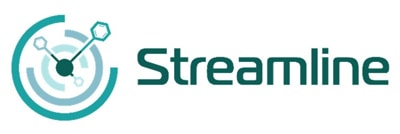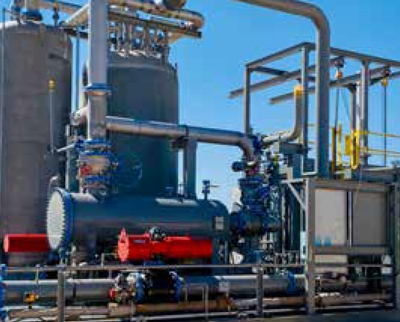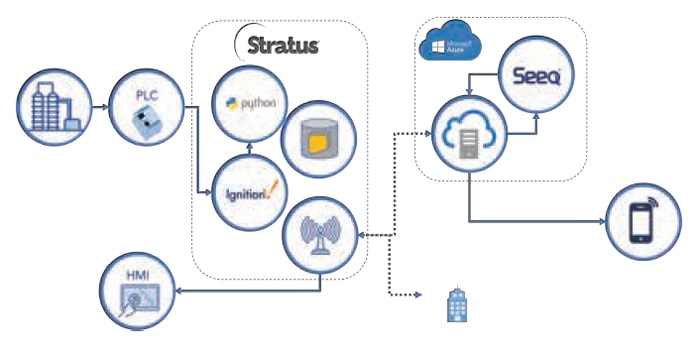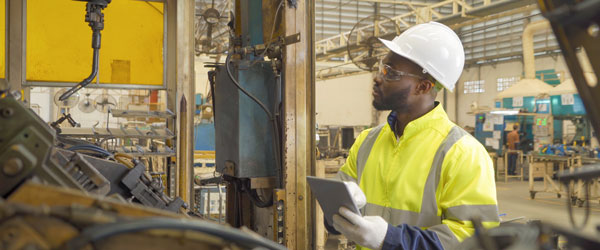Case Study
Streamline Innovations
Edge Computing in Oil & Gas
How Streamline Innovations uses Stratus Edge Computing to bring AI-powered predictive maintenance, remote operation, and 99.5% uptime to remote oilfield equipment.

Challenges
- Identify an Edge Computing platform to deploy OT and IT capabilities for precise monitor and control of proprietary H2S removal process
- Operate with limited data connectivity in remote Oil & Gas locations
- Deliver on customer SLA of minimum 95% uptime and meet customers’ automation budgets
Solution
- Deploy Stratus ztC Edge™ to develop, host, and protect Valkyrie Intelligent Platform™ (VIP)
- Leverage Stratus built-in virtualization to run Inductive Automation, PostgreSQL database, and Python™ and layer Seeq AI software
- Connect ztC Edge to WAN for cloud data analysis, remote visibility, and full functionality
Benefits
- Enabled real-time data analysis, HMI, visibility, and tracking of 50 KPIs from a control room five hours away
- Reduced required onsite staffing by 66%, saving time and cost, using AI-powered predictive maintenance
- Achieved 99.5% uptime in remote location, surpassing customer SLA of 95%, and met customer cost point
From Smart to Intelligent Oilfield Equipment with Edge Computing
Streamline Innovations, based in San Antonio, Texas, develops and operates a proprietary hydrogen sulfide (H2S) gas treating process called Valkyrie™ which reduces toxic H2S to elemental sulphur used in fertilizer. The result is a novel clean tech process that eliminates pollution for Oil & Gas, Water & Wastewater, landfills, and biogas.
Using Stratus Edge Computing, Streamline Innovations brought intelligence and remote operations to complex process skids and enabled continuous operation, surpassing customer expectations. With its Valkyrie Intelligence Platform (VIP) using Stratus ztC Edge, the company monitors units remotely with 99.5% uptime and reduced onsite staffing requirements from 6 FTEs to 2 FTEs. Data is sent from the ztC Edge to Microsoft Azure for a centralized view of equipment that is accessible remotely from control centers and operator trucks. With Induction Automation HMI/SCADA, a PostgreSQL database, and Python Linux running concurrently on ztC Edge, the team has precision process control with “tiered” intelligence to monitor and analyze performance minute-to-minute and hour-to-hour with centralized analysis day-to-day and week-to-week.
Deploying Proprietary Clean Tech in Remote Oil & Gas Production

Streamline Innovations’ Valkyrie sulphur removal process is particularly effective in upstream Oil & Gas, where H2S is abundant in the production process. The company deploys its proprietary process on skids at remote sites that often have no daytime access for staffing, introducing several unique challenges.
The Valkyrie process consists of two chemical reactions that must be controlled in an exquisitely narrow band. Throughout operations, the process must adapt to minute-to-minute and day-to-day changes in gas flow rates and H2S concentration. Additionally, the team must closely control, monitor, and maintain pumps, filters, lines, and valves – usual industrial equipment – handling multiphase material. Streamline Innovation’s complex process therefore required precise control of both the chemical process and the mini plant.
Given the remote locations, the team must work with very low data connectivity and monitoring requires on-site trained experts around-the-clock. Streamline Innovation sought to address these challenges to do more with less by bringing intelligence to their oilfield process and meet customers’ automation budgets.
“Using Stratus, we have built smart plants that are managed remotely by Artificial Intelligence and visible from any location 24/7.”
Peter Photos
CTO
Streamline Innovations
Stratus Edge Computing Opens the Door to Intelligent Oilfield Equipment
Streamline Innovations selected the Stratus ztC Edge computing platform to maximize process reliability and bring new remote capability and intelligence to its Valkyrie process.
Dr. Peter Photos, Chief Technology Officer of Streamline Innovations explained, “We spent a tremendous amount of time testing out a lot of different edge computing devices and finding the right technology. We were first attracted to the potential of ztC Edge because it offered truly redundant processing. Two ztC Edge units operate as a redundant pair, this means that if one unit fails for any reason, the other can continue without a break in service. The elimination of downtime is unmatched in the Edge Computing environment.
“Another huge advantage became obvious as we explored the ztC Edges virtualization capability to solve our client’s specific requirements. We’re running three virtual machines. Our first virtual machine is Inductive Automation Ignition running our OPC Server and data acquisition. The second virtual machine is a PostgresSQL database, and then our third virtual machine is a Python Linux Box, running Python scripts. With the extensive computing power available of ztC Edge, we’re able to get a nice, chunky powerful computer that’s able to do all the calculations we want.”
Peter continued, “So we have the Valkyrie connected to a PLC, which is performing minute-to-minute calculations. We have the Stratus ztC Edge that is doing real-time calculations, running Python, collecting historical data, running Ignition, and communicating via the Wi-Fi. The data is sent to an Azure database out in the cloud where we do day-to-day, week-to-week, and month-to-month computations. It is integrated with Seeq, an artificial intelligence software that calculates our sophisticated modelling.
“The Valkyrie Intelligence Platform is now a standalone box that can be integrated into an existing unit and applied for any process. It is powered by Stratus, with Seeq running in the background doing artificial intelligence and complex calculations like predictive maintenance.”
Architecture for Data Collection and Tiered Intelligence
The Valkyrie Intelligent Platform provides intelligence across multiple tiers. The programmable logic controller (PLC) is on the first tier, ztC Edge runs on the next layer, and the cloud is the topmost tier. Each has a specific role that makes the most of its inherent strengths, for example, taking advantage of the strong bandwidth between the PLC and the ztC Edge to manage large volumes of data in real time. Where the bandwidth falls between the edge and the cloud environments, less data is transmitted, enabling the huge processing power of the cloud to do much heavier calculations. This allows Streamline Innovations to run machine learning, which feeds information back to operational management, enabling predictive and preventive maintenance at a site level.
With ztC Edge’s virtual machines and power, Streamline Innovation is able to continue to iterate and incorporate new intelligence. Dr. Photos added, “We have JavaScript, we have Python scripts. We have a modem, let’s go to the National Weather Service. We pull in the forecast for the next six hours of weather, and we determine our heater temperature based off of that. We’re able to shut down our units during tornado warnings.”

Remote Customer Deployment in the Permian Basin
Streamline Innovations deployed multiple Valkyrie units for a Super Valkyrie customer project in Pecos, Texas to treat 16 million cubic feet of gas. The project comprises three Amining Plants and three remote Valkyrie skids spread across eight miles. The customer required a minimum of 95% uptime and a set budget.
Using its intelligent platform, Streamline Innovations connected its units to a TropOS wide area network (WAN) to enable remote control room visibility and connection by mobile devices.
While such a solution would normally require six full-time operators and extensive on-call maintenance capability to run 24/7, the goal is to operate it with two full-time personnel and minimal offsite maintenance staff.
From its San Antonio headquarters, teams monitor 50 key performance indicators (KPIs) from the remote units. The Inductive Automation Ignition software running in the control room directs maintenance and callouts, making diagnostics and repairs more efficient. With the additional machine learning and predictive maintenance capabilities maintenance is less frequent.
Dr. Photos explains, “What the operator sees in the control room, the skids, and in the San Antonio HQ are all the same. Our control system supervises the entire unit, and that gives us tremendous value.”
“With this approach, there’s no barrier to building smart equipment to span the entire oil and gas pathway from the wellhead to sales. Edge is the future of IT and OT.”
Peter Photos
CTO
Streamline Innovations
New Opportunities for Oilfield Intelligence

The Super Valkyrie project using ztC Edge enabled smart Amine plants and units to run at 99.5% uptime – comfortably exceeding the 95% minimum stipulated by the customer with full visibility, functionality, and analysis from the central control room hours away. Staffing requirements were reduced 66% and contributed to meeting the customer’s automation budget.
“Having seen what the Stratus Edge Computing platform is capable of in a complex solution such as the Valkyrie, it’s clear that edge technology has a lot to offer the Oil and Gas industry – smart wellheads, smart glycol units, smart JT (Joule Thomson) skids, and more.
“We’ve made Valkyrie Intelligent Platform a turnkey package, which is what makes it so simple. And with the remote monitoring capability, it all becomes modular. We are taking the Stratus technology that is available off the shelf and putting it into boxes, and turning an operational technology project into a service.”






